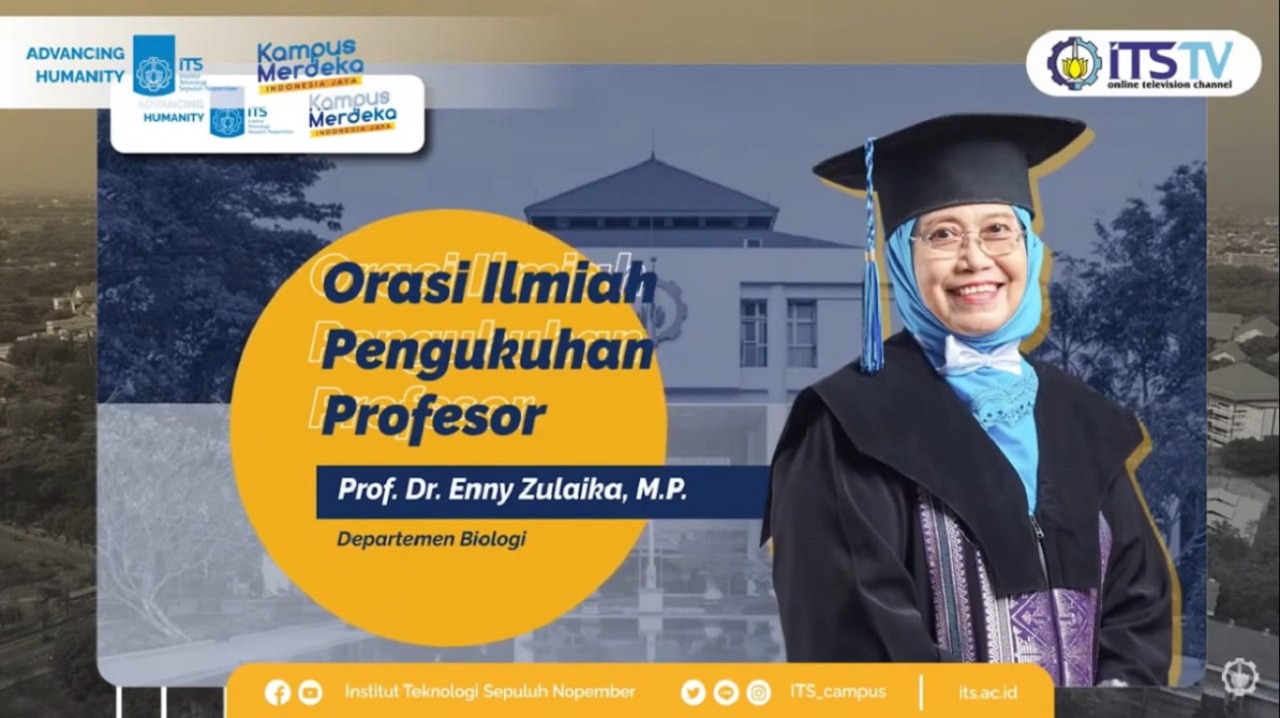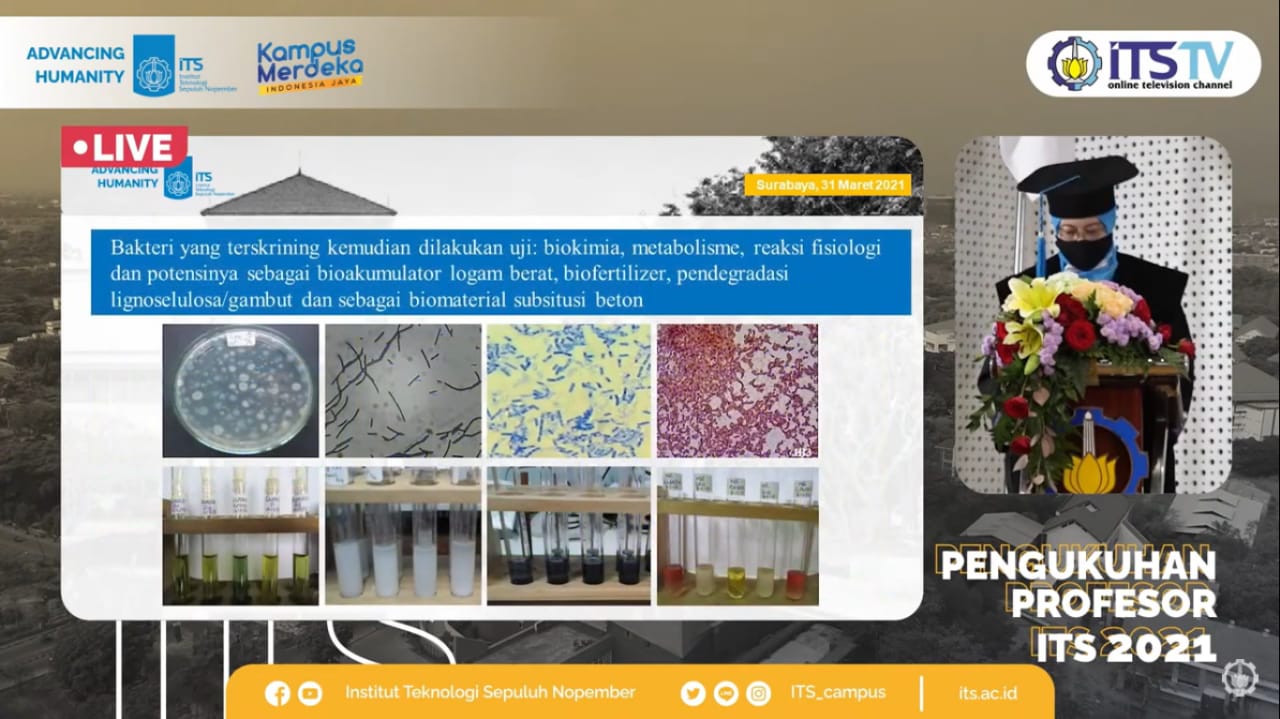ITS Professor Reduces the Risk of Using Peatlands by Utilizing Bacteria

Prof. Dr. Enny Zulaikha MP, ITS Professor from the ITS Biology Department, inaugurated on March 31, 2021
ITS Campus, ITS News – The increasing need for housing and transportation facilities makes the use of peatlands an unavoidable option. That also led to an increase in heavy metal pollution. For this reason, Prof. Dr. Enny Zulaika MP, one of the professors of Institut Teknologi Sepuluh Nopember (ITS), provided an alternative in the form of using bacteria that can use to overcome the above problems without causing environmental damage
Enny explained that peat soil has a very high pore number and water content. It causes the Soil bearing capacity to below, and the ability to compress it is very long. “The decomposition process needs to be accelerated so that compression and reduction of soil shear strength will not occur after construction operated,” said the lecturer at the Department of Biology.

Prof. Dr. Enny Zulaikha MP delivering her scientific oration inauguration as ITS Professors
Therefore, according to Enny, an alternative that can use is an environmentally friendly biological method. Namely through the bioaugmentation of local peat lignocellulolytic bacteria. With this method, the stabilization of peat aggregates will be accelerated and feasible for construction. “After passing the biochemical, metabolic, physiological, and PCR tests of the 16S rRNA gene, the peat bacteria identified as Pseudomonas-taiwanensis U3-MT373534 and B. cereus U4-MT373535,” explained Enny who wrote her research in his scientific oration as ITS governor on March 31. then.
The woman who was born in Madiun, January 9, 1960, added that peat bacteria are generally lignocellulolytic and can enzymatically degrade lignin and cellulose. The process of decomposition of peat fibers by bacteria can be proven from changes in the structure of its functional chemical groups which become simpler using Fourier Transform Infrared Spectroscopy (FTIR).
The peat bacteria, he continued, were able to decompose peat fibers of more than 80 percent. Bacteria that are said to be superior can also be released back into the peat so that they can reproduce. “This is done so that when the peat which functions as a source of nutrition is used up, bacteria can switch to the surrounding peat to provide adequate nutrition,” she explained

The decomposition of peat fibers by lignocellulolytic bacteria was researched by ITS professor Prof. Dr. Enny Zulaikha MP
Also, for the case of heavy metals, Mercury (Hg) is one of the biggest contributors to environmental pollution whose biological function is not yet known clearly. Although the Indonesian Minister of Health has required an allowable mercury concentration of 0.001 ppm, heavy metal reduction techniques must be pursued immediately. “The problem is, although currently a lot of research is being developed related to heavy metals, the costs incurred are quite expensive,” she said.

Bacteria that have been isolated and have been tested in biochemistry, metabolism, physiology, and their potential
Bacteria can indeed be used as an alternative to bioremediation. For example, the cereus bacteria strain obtained from Kalimas Surabaya. According to Enny, these bacteria were able to reduce Hg and Cd metals by more than 50 percent and Pb, Cu, and Fe metals by more than 75 percent. “With these bacteria, pollution recovery can be faster, renewable, and the cost is relatively cheap,” she said.
According to the mother of three children, bacteria should not be seen as invisible bodies and harm humans only. If studied further, it turns out that bacteria can provide many benefits for advances in science and technology. “In the future, I hope to continue to contribute work to ITS and the Indonesian people,” she concluded hopefully. (pan/ITS Public Relations)
Reporter: Erchi Ad’ha Loyensya
Related News
-
Touching Moments of ITS Graduates Who Died Before Graduation
ITS Campus, ITS News – An emotional atmosphere enveloped the graduation ceremony on the first day of the 129th
April 20, 2021 21:04 -
Achieving a GPA of 3.82, Septia Becomes the Best Graduate of the ITS Applied Bachelor’s Degree
ITS Campus, ITS News — Not only from the regular undergraduate (S1) program, but the applied undergraduate (D4) program at
April 20, 2021 21:04 -
At 19 Years Old, Giselle Was Confirmed as The Youngest Graduate at ITS
ITS Campus, ITS News — Even at 19 years and 9 months old, Giselle Hage was officially confirmed as the
April 20, 2021 21:04 -
Supporting the Development of Material Processes, ITS Professors Utilize Biomass Waste
ITS Campus, ITS News — Innovation in material processes continues to develop to support society’s need for environmentally friendly
April 20, 2021 21:04
